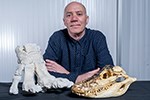Pairing and sharing in V formation flight
New publication reveals how birds can't 'cheat' in V formation flight by spending all their time at the back.
Research published in Nature last year by the RVC Structure and Motion Lab showed that when birds are flying in a V formation, energy savings can be achieved by using the aerodynamic up-wash produced by the preceding bird. This means that the leading bird in a formation uses the most energy to fly.
New research, published in the journal PNAS, begins to explain why, if it is so much easier to fly at the back of a V, birds change their position rather than trying to stay at the back. For the study, the RVC team developed miniature GPS and motion sensing loggers that could be carried by a flock of juvenile northern bald ibis (Geronticus eremita) during human-led migration flight. The data showed that pairs of birds take turns, matching the time spent leading and in the wake position and sharing the benefit. This pairing-and-swapping behaviour is likely to prevent 'cheating' by individuals. The research also found evidence that taking turns in leading has a substantial influence on the size and cohesion of the flight formations.
This research was undertaken in collaboration with the Waldrapp conservation team and the University of Oxford.
Reference: Voelkl, B, Portugal SJ, Unsold, M, Usherwood, JR, Wilson, A and Fritz, J (2015) Matching times of leading and following suggest cooperation through direct reciprocity during V-formation flight in ibis. PNAS published ahead of print February 2, 2015, doi:10.1073/pnas.1413589112
The full article can be read in PNAS.


You may also be interested in:
-
RVC’s Professor John Hutchinson elected Fellow of prestigious Royal Society
John Hutchinson, Professor of Evolutionary Biomechanics at the Royal Veterinary College (RVC), has …

